New Mexico’s desert plains, pine forests, and rugged canyons are home to an incredible diversity of wildlife — including several fascinating species of skunks. Known for their distinct black-and-white coats and unmistakable defense spray, skunks play an essential role in balancing the ecosystem by controlling insect and rodent populations. From the wide-ranging Striped Skunk to the elusive Hooded Skunk of the southern desert, each species has its own fascinating habits and habitats. In this guide, we’ll take an in-depth look at the Types of Skunks in New Mexico — exploring their appearance, behavior, diet, and how they coexist with humans across the Land of Enchantment.
1. Striped Skunk (Mephitis mephitis)
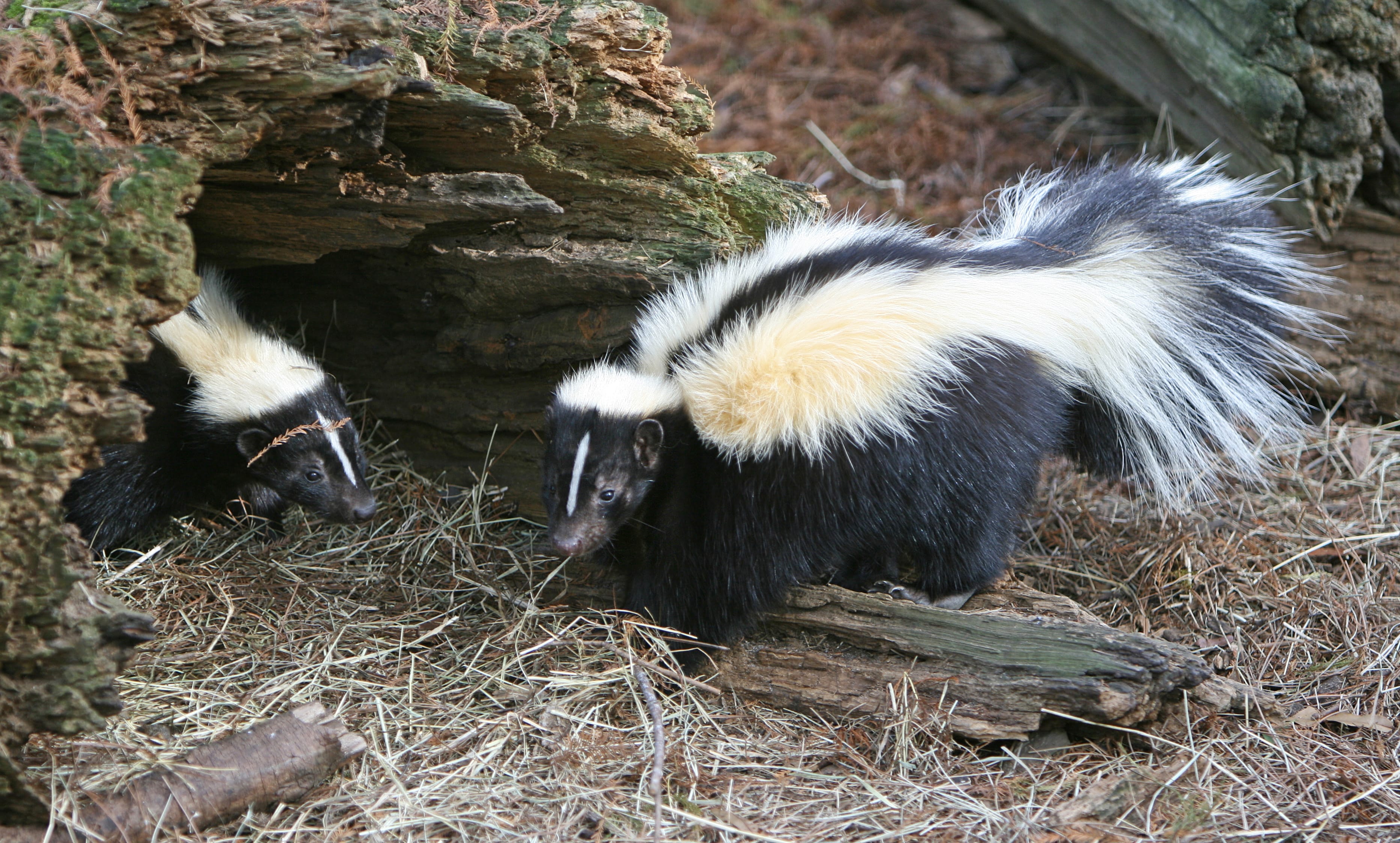
Physical Characteristics & Identification Tips
The Striped Skunk is arguably the most recognizable skunk species across North America — and certainly the most widespread in New Mexico. Its signature black fur with two bold white stripes running from the head down to the tail gives it away almost instantly. Adults typically measure around 22–30 inches in total length, including a bushy tail that makes up about a third of that. Weighing between 4 and 10 pounds, these mammals have stocky legs and long claws that make them excellent diggers. Interestingly, the width of their stripes can vary from skunk to skunk, and some individuals may even appear almost completely white or black, giving them a surprising degree of variation.
Behavior
Striped Skunks are nocturnal, meaning they’re most active at night when they roam fields, woodlands, and even suburban neighborhoods searching for food. Their movements are slow but deliberate, and while they’re not fast runners, they compensate with an iconic defense mechanism — their foul-smelling spray. When threatened, a Striped Skunk will stomp its feet, raise its tail, and twist its body into an “S” shape before unleashing a pungent mist that can reach up to ten feet. It’s nature’s version of a “keep your distance” sign, and predators like coyotes and foxes have learned to respect it.
Habitat and Range
Across New Mexico, the Striped Skunk can be found almost everywhere — from the farmlands near Roswell to the forested areas of Taos and the arid outskirts of Las Cruces. They thrive near water sources, using hollow logs, burrows, or even abandoned buildings as dens. Their adaptability to human-altered environments is remarkable, allowing them to survive comfortably near small towns or ranches where food sources like insects and small rodents are abundant.
Diet
The Striped Skunk’s diet is as diverse as its habitat. They are opportunistic feeders, eating insects, small mammals, amphibians, fruits, and even garbage when available. In the summer, they feed heavily on beetles, crickets, and grasshoppers, while in the cooler months they’ll dig up roots or raid bird nests for eggs. This varied diet helps keep local pest populations under control — one reason many ecologists consider them unsung heroes of pest management.
Reproduction and Life Cycle
Breeding season occurs between February and April, with females giving birth to four to seven kits after a gestation period of about two months. The young are born blind and nearly hairless but quickly develop the recognizable black-and-white pattern within a couple of weeks. By late summer, they’re ready to explore the world alongside their mother, learning where to forage and how to defend themselves. By autumn, most juveniles disperse to find their own territories.
Fun Facts / Unique Traits
Did you know that Striped Skunks can’t spray indefinitely? They have limited glandular reserves and need several days to replenish their musk after discharging it. Also, contrary to popular belief, these animals don’t spray indiscriminately — it’s a last resort used only when escape or warning signals fail. Many people who encounter them up close are surprised to find that they’re gentle, curious, and surprisingly tolerant if left unbothered.
Human Interaction
In New Mexico, Striped Skunks sometimes make themselves a little too comfortable near homes, raiding trash cans or setting up dens under porches. While this can cause occasional nuisance issues, it’s easy to mitigate by securing food sources and sealing potential entry points. Skunks, for their part, help keep property free of insects and rodents, making them both neighbor and pest control ally. If you ever see one waddling across your yard at dusk, consider it an ecological bonus rather than a threat.
2. Hooded Skunk (Mephitis macroura)
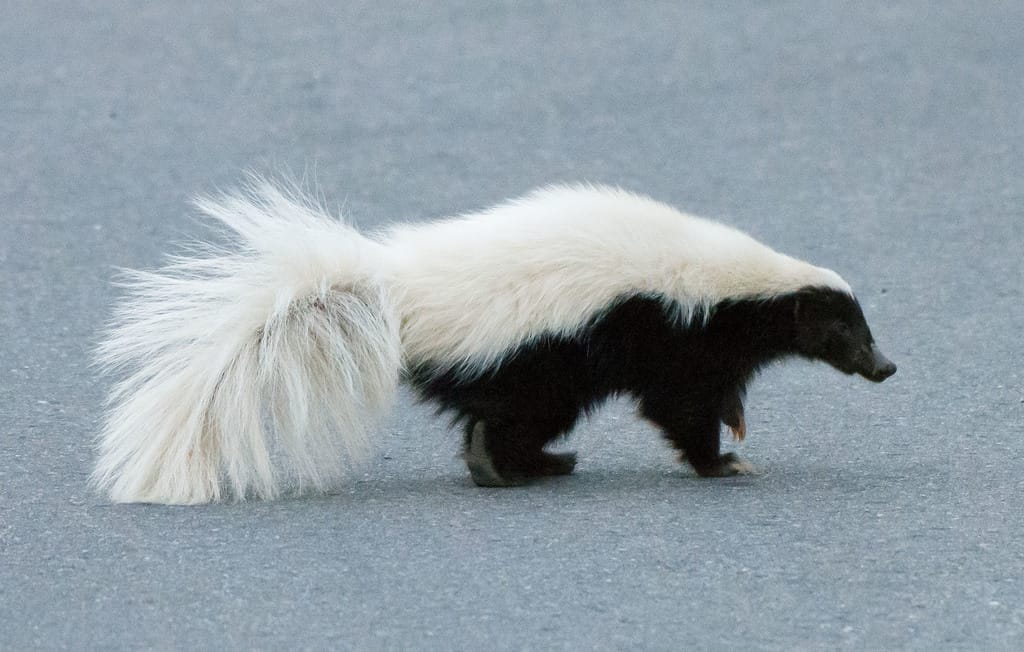
Physical Characteristics & Identification Tips
The Hooded Skunk looks like a sleek cousin of the Striped Skunk but with a few stylish twists. True to its name, this species often has a long, flowing mane of white fur running from the head to the shoulders, creating a “hooded” appearance. It may appear almost entirely white or black with just a thin dorsal stripe — a variation that has led locals to nickname it the “ghost skunk.” Slightly larger than its striped relative, the Hooded Skunk has a narrower body and a longer tail, sometimes exceeding 16 inches. Its fur is softer and more luxuriant, especially noticeable under the New Mexico moonlight.
Behavior
This skunk species is primarily nocturnal but tends to be more agile and curious than its striped counterpart. It’s an adept climber — something not often associated with skunks — and can occasionally be seen scaling low trees or fences in search of insects. The Hooded Skunk is less aggressive and slower to spray, preferring to retreat when startled. Its behavior has earned it a somewhat “gentlemanly” reputation among wildlife watchers, as it often forages peacefully without confrontation.
Habitat and Range
In New Mexico, the Hooded Skunk is mostly found in the southern and western parts of the state, particularly around the Rio Grande Valley and desert scrublands near Las Cruces and Alamogordo. It thrives in arid and semi-arid environments, often making its home in abandoned burrows, rocky crevices, or under desert vegetation. During colder months, it may share dens with other skunks — a surprisingly social adaptation for an otherwise solitary animal.
Diet
The Hooded Skunk’s diet consists largely of insects, small reptiles, and fruits. It’s especially fond of beetles, grasshoppers, and crickets but also enjoys prickly pear fruit when available. Like the Striped Skunk, it has a taste for variety and may dig into soil for grubs or rummage around human settlements for scraps. Farmers often benefit from their insect-eating habits, though they might not always appreciate the occasional chicken egg theft!
Reproduction and Life Cycle
Breeding occurs in late winter, and after about 60 days, females give birth to three to six kits in hidden dens. The young are dependent for several weeks before gradually venturing outside. Hooded Skunks tend to breed only once per year, and both parents may occasionally be seen together near den sites, although males usually move on afterward. The species’ population is stable in New Mexico, though it’s less frequently seen than its striped cousin due to its preference for remote habitats.
Fun Facts / Unique Traits
One particularly fun fact: Hooded Skunks produce a musk that smells slightly milder and sweeter compared to other skunk species. Some old-timers in southern New Mexico even claimed they could “tell the species by scent alone.” Whether that’s true or simply desert folklore is anyone’s guess, but it’s an amusing piece of local lore that endures. Their beautiful coat has also made them a subject of fascination for wildlife photographers and biologists alike.
Human Interaction
Though rarely aggressive, Hooded Skunks occasionally wander into residential gardens or campgrounds. They’re less prone to digging up lawns but may be drawn to pet food or compost bins. Because of their docile nature, relocation efforts for nuisance individuals are typically straightforward. For many New Mexicans, spotting one of these “ghostly” skunks in the moonlight is an unexpected but memorable encounter.
3. Western Spotted Skunk (Spilogale gracilis)

Physical Characteristics & Identification Tips
Arguably the most eye-catching skunk in New Mexico, the Western Spotted Skunk is a small, agile species adorned with intricate white blotches and broken stripes across its body. Unlike the more straightforward patterns of other skunks, this one seems like it was painted by an artist with a wild imagination. Adults measure only 16–24 inches in length and weigh around 1–2 pounds, making them much smaller and more nimble than Striped or Hooded Skunks. Their tails are long and bushy, tipped with white fur, which often waves dramatically when the animal feels threatened.
Behavior
Western Spotted Skunks are known for their incredible acrobatics. When threatened, they perform a “handstand” — balancing on their front paws with their tail raised high as a warning display. If that fails to deter the threat, they unleash their potent spray, but observers often note how comically theatrical the prelude can be. These skunks are more active and energetic than their larger relatives, darting swiftly between cover and scaling fences or low trees. They are primarily nocturnal but may show some activity at dawn and dusk, especially during cooler months.
Habitat and Range
In New Mexico, Western Spotted Skunks inhabit rocky canyons, pine forests, and desert foothills. They’re particularly common around the Gila National Forest and other rugged southwestern regions. Unlike Striped Skunks, they prefer denser cover and often shelter in rock crevices or under piles of wood. During the winter, they enter a period of partial dormancy — not true hibernation but a slowed metabolism that helps them conserve energy during cold spells.
Diet
Their diet includes insects, small rodents, and occasionally berries. They’re exceptional hunters of mice and voles, often using their agility to chase prey into tight spaces. They also consume grasshoppers, beetles, and occasionally small birds or reptiles. The Western Spotted Skunk’s adaptability in diet has made it a successful species across a wide range of habitats in New Mexico.
Reproduction and Life Cycle
These skunks have a fascinating reproductive adaptation known as “delayed implantation.” After mating in late summer, the fertilized egg doesn’t immediately develop. Instead, it remains dormant until late winter, when it finally implants and begins growth. This allows the female to give birth to her litter — usually four to six kits — at a time when conditions are optimal. It’s nature’s way of synchronizing birth with abundance of food and warmth.
Fun Facts / Unique Traits
Aside from their acrobatics, one of the Western Spotted Skunk’s quirky habits is its cat-like grooming. It frequently cleans its fur and tail, keeping its striking coat in immaculate condition. Its scent glands also produce a slightly different chemical composition than the Striped Skunk’s, which biologists say makes it “spicier” and more pungent. If you think you’ve smelled one, you’d probably never forget it.
Human Interaction
While less likely to invade urban spaces, Western Spotted Skunks occasionally take shelter in barns, sheds, or under decks. Farmers often tolerate them due to their beneficial habit of preying on crop pests. Still, their musk can be a serious deterrent if one takes up residence too close to human habitation. Wildlife control professionals usually recommend humane exclusion — sealing entry points and allowing the skunk to move on naturally rather than trapping or killing it.
4. Eastern Spotted Skunk (Spilogale putorius)
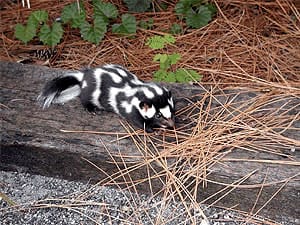
Physical Characteristics & Identification Tips
Among the more elusive skunks in New Mexico, the Eastern Spotted Skunk is a smaller, slimmer cousin of the Western Spotted Skunk. Measuring around 18 to 24 inches long and weighing less than 2 pounds, this species is best known for its broken white stripes and spots, forming a pattern that looks more like a painter’s splash than a uniform design. The tail is long and plumed, usually tipped with white, and the head sports a narrow white line between the eyes. Compared to other skunks, it has a sleeker build and more agile posture, making it look almost like a weasel wearing a tuxedo.
Behavior
Eastern Spotted Skunks are famously acrobatic and can perform impressive handstands to warn off predators — a behavior shared with their western relatives. However, they’re also skilled climbers, capable of scaling trees and fences in search of insects or bird nests. They’re primarily nocturnal and prefer solitude, except during mating season. When threatened, they give several warnings before resorting to spraying, often stamping their feet or clicking their teeth. Observers often describe their handstand display as both comical and graceful, almost like a tiny gymnast showing off its balance before disappearing into the underbrush.
Habitat and Range
While the Eastern Spotted Skunk is generally more common east of the Mississippi, small populations persist in eastern New Mexico, particularly in wooded canyons and grasslands near the Texas border. They prefer habitats with dense vegetation and plenty of cover, often denning in hollow logs, rock piles, or even under abandoned farm structures. Unlike Striped Skunks, which thrive near urban environments, Eastern Spotted Skunks tend to avoid human-dominated areas, relying instead on remote terrain to stay safe from predators and habitat disruption.
Diet
This species is an opportunistic feeder, consuming a balanced mix of insects, small mammals, and fruits. Grasshoppers, beetles, and crickets make up a large portion of their summer diet, while in winter, they turn to rodents and bird eggs. Occasionally, they’ll feast on wild berries or fallen fruit, particularly when insects are scarce. Their preference for pest insects means they contribute to natural pest control, quietly helping farmers and ranchers manage bug populations without ever sending a bill for their services.
Reproduction and Life Cycle
Breeding occurs in late winter, but like the Western Spotted Skunk, females delay implantation until conditions are favorable. This results in spring births of four to six kits, born blind and helpless. The young open their eyes after about three weeks and stay with their mother until early fall. Eastern Spotted Skunks mature quickly, reaching reproductive age by their first year — a strategy that helps maintain population stability despite natural predation and human impact.
Fun Facts / Unique Traits
Here’s a curious tidbit: Eastern Spotted Skunks have been observed performing short “dances” during courtship, where males stamp, twist, and prance around females in a comical display of enthusiasm. It’s one of those moments in nature that reminds us — even the smelliest of mammals can have a flair for romance! These skunks are also more vocal than others, producing chirps, squeaks, and even soft growls when disturbed.
Human Interaction
Because they’re shy and elusive, encounters with Eastern Spotted Skunks are relatively rare in New Mexico. However, they occasionally turn up near rural farms, attracted by haystacks or barns that harbor small rodents. While they can spray if cornered, they usually prefer to flee. Conservationists are monitoring populations carefully since habitat loss and pesticide use may be reducing their numbers. For rural landowners, spotting one of these agile creatures is often a sign of a healthy, balanced ecosystem.
5. Hog-nosed Skunk (Conepatus leuconotus)
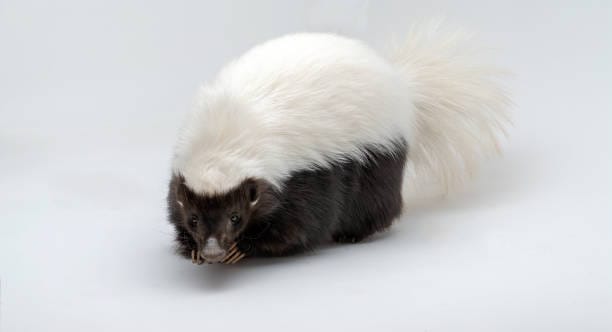
Physical Characteristics & Identification Tips
The Hog-nosed Skunk, also known as the American Hog-nosed Skunk or “rooter skunk,” is one of the most distinctive Types of Skunks in New Mexico. It earns its name from the prominent, pig-like snout that it uses to dig up insects and roots. This skunk is larger than most — adults can measure up to 36 inches long and weigh between 4 and 10 pounds. Its fur is strikingly patterned, with an entirely white back and tail contrasting sharply against jet-black sides and legs. Unlike other skunks with two stripes, this species has a single wide white stripe running from its head to tail tip, resembling a blanket draped over its back.
Behavior
Hog-nosed Skunks are solitary, mostly nocturnal animals that spend their nights rooting through soil and leaf litter in search of food. Their long front claws make them exceptional diggers, and they’re often seen leaving small cone-shaped holes in soft ground — a telltale sign of their foraging. They are less likely to spray than Striped Skunks, preferring to rely on their size and digging ability to escape danger. If pressed, however, they can unleash a strong musk that rivals any other skunk’s potency.
Habitat and Range
This species inhabits southern and central parts of New Mexico, particularly along desert washes, rocky canyons, and grasslands. They favor semi-arid landscapes with soft soils that are easy to dig through. Hog-nosed Skunks often den in rocky crevices or self-dug burrows and may change dens several times a year depending on weather and food availability. Interestingly, their population density tends to fluctuate seasonally — with more sightings in wet years when insects are plentiful.
Diet
Their diet is a protein-rich mix of beetles, grubs, and small vertebrates. They are especially fond of scorpions and even venomous centipedes — a testament to their toughness and specialized palate. They’ll also eat fruits, roots, and occasionally carrion. Farmers sometimes notice them digging in fields after rainstorms when soil insects are closer to the surface. Despite occasional complaints about holes in lawns or gardens, their role in controlling insect pests is undeniable.
Reproduction and Life Cycle
Breeding occurs in early spring, with females giving birth to two to five kits after a gestation period of about two months. The young stay with their mother until late summer, learning to forage and dig. Like most skunks, Hog-nosed Skunks are highly independent from an early age, dispersing by fall to establish their own territories. They live up to six years in the wild, though most fall prey to predators like coyotes, bobcats, or great horned owls before reaching old age.
Fun Facts / Unique Traits
Unlike other skunks, Hog-nosed Skunks emit a softer purr when content — almost like a cat’s! They’re also known for their surprisingly strong forelimbs, which some researchers compare to small badgers in digging ability. Native peoples once referred to them as “earth pigs” due to their snouts and burrowing behavior. And yes — they can dig a den faster than you can brew your morning coffee.
Human Interaction
While rarely seen, Hog-nosed Skunks occasionally wander onto rural properties, especially after rains. They are shy and pose little danger, but their foraging habits can make them minor nuisances to gardeners. Still, they provide valuable ecological services by consuming agricultural pests. In New Mexico folklore, they’re sometimes seen as symbols of balance — creatures that transform decay into life by aerating the soil and keeping insect populations in check.
6. American Pygmy Spotted Skunk (Spilogale pygmaea)

Physical Characteristics & Identification Tips
Among all skunks, the American Pygmy Spotted Skunk stands out as the tiniest and most delicate. Averaging just 13–15 inches long and weighing under one pound, it could almost fit into a small handbag (though, for obvious reasons, you wouldn’t want to try). Its coat features dazzling white spots and stripes against glossy black fur, giving it an almost ornamental look. The face is short and narrow, with large eyes and a bushy tail that seems oversized for its small body. Because of its petite size and secretive nature, it’s one of the least observed skunks in New Mexico.
Behavior
Pygmy Spotted Skunks are quick, agile, and incredibly nimble for their size. They can dart between rocks and underbrush with ease, and like their larger cousins, they perform the iconic handstand display when alarmed. However, their spray is weaker — more of a deterrent than a weapon. These skunks are nocturnal but may occasionally be seen in the early morning hours searching for insects. Their movements are light and deliberate, resembling a mix between a squirrel and a ferret.
Habitat and Range
Found primarily in southern New Mexico, especially near the Mexican border, this skunk inhabits dry scrublands, rocky slopes, and desert grasslands. It favors areas with loose soil and scattered vegetation, often sharing its range with Hooded and Hog-nosed Skunks. Due to its small size, it uses narrow burrows, rock piles, or even abandoned rodent tunnels for shelter. Populations are patchy, and sightings are rare, leading researchers to believe it may be one of the most localized skunks in the state.
Diet
The American Pygmy Spotted Skunk feeds primarily on insects — ants, beetles, crickets, and caterpillars form the bulk of its diet. Occasionally, it supplements with small lizards, fruits, and bird eggs. It’s a precise and efficient hunter, often seen digging delicately into the soil or overturning leaves to uncover prey. Because of its tiny size, it poses no threat to crops or livestock and instead acts as a natural pest regulator in its desert ecosystem.
Reproduction and Life Cycle
Females typically breed once a year, giving birth to two to four kits in early spring. The young mature quickly, often leaving their mothers by midsummer to establish their own tiny territories. Given their small stature and vulnerability to predators, pygmy skunks rarely live more than four years in the wild. However, their rapid reproduction helps maintain small but steady populations in isolated regions.
Fun Facts / Unique Traits
This species is so small that it has sometimes been mistaken for a baby Western Spotted Skunk! In fact, early naturalists once classified it as such until DNA evidence proved otherwise. Locals occasionally refer to it as the “mini skunk” or “pocket skunk,” both affectionate names that reflect its diminutive size. Despite being tiny, its bravery is remarkable — standing its ground against predators many times its size when cornered.
Human Interaction
Encounters with Pygmy Spotted Skunks are exceedingly rare. Most people in New Mexico have never seen one outside of field studies or photographs. Still, their presence is an indicator of healthy desert ecosystems. They pose no real conflict with humans and are protected in some areas due to limited range and population size. Seeing one in the wild is a genuine privilege — the kind of moment that wildlife enthusiasts dream about.
7. Western Spotted Skunk (Spilogale gracilis)
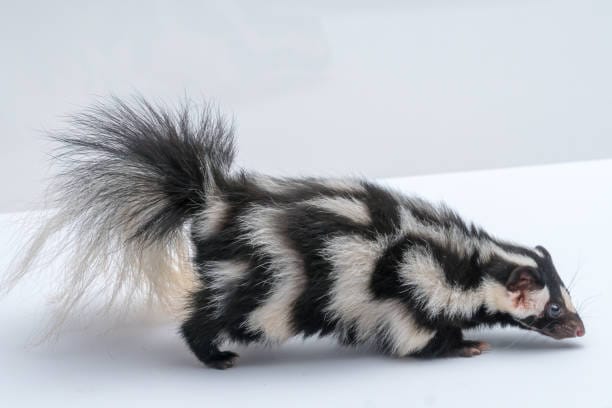
Physical Characteristics & Identification Tips
The Western Spotted Skunk is a nimble, small-bodied skunk known for its bold and irregular white stripes and spots against deep black fur. Adults typically measure 18–26 inches in length and weigh 1.5–3 pounds. Compared to other skunks, this species has a more slender, weasel-like build and a bushy tail often tipped in white. Its face is adorned with a narrow stripe running from the forehead to the nose, and its limbs are comparatively long, giving it an agile and athletic appearance. Quick observation of these markings is the easiest way to distinguish it from Eastern Spotted Skunks.
Behavior
Western Spotted Skunks are famous for their acrobatics: when threatened, they may stand on their forelimbs, raise their hindquarters, and wave their tail in a dramatic display to warn off predators. They are nocturnal hunters, highly skilled at climbing trees, fences, and rocky outcrops. Solitary for the most part, they use a combination of stealth and agility to capture insects, small mammals, and eggs. Their odoriferous spray is potent but usually a last resort; they prefer to flee or display rather than engage.
Habitat and Range
They inhabit western and central New Mexico, favoring grasslands, shrublands, and forest edges. This species thrives in areas with plenty of cover, often denning in rocky crevices, hollow logs, or abandoned burrows. Its adaptability allows it to coexist near rural farms and ranches, provided there’s sufficient natural vegetation and prey availability. Seasonal movements are minimal, though they may shift dens slightly depending on temperature and food availability.
Diet
Western Spotted Skunks are omnivorous. Insects — beetles, grasshoppers, and crickets — dominate their diet, while small rodents, bird eggs, fruits, and berries supplement it. Occasionally, they scavenge carrion. Their foraging habits are precise and methodical, often flipping rocks and leaves to uncover hidden prey. These skunks are natural pest controllers, quietly keeping insect and rodent populations in balance within their ecosystem.
Reproduction and Life Cycle
Breeding occurs in late winter, with delayed implantation ensuring births occur in spring when resources are abundant. Litters consist of two to six kits, born blind and helpless. The mother raises them alone, teaching them how to hunt and forage over several months. Western Spotted Skunks reach maturity by their first year and may live up to seven years in the wild. Their reproductive strategy balances the small population density with the pressures of predation and habitat fluctuation.
Fun Facts / Unique Traits
Unlike many other skunks, Western Spotted Skunks often perform a “handstand dance” that can last several seconds before spraying. This display has fascinated biologists and casual observers alike, blending both warning and theatrical showmanship. They are also more vocal than Striped Skunks, producing chirps, growls, and purring sounds during mating or social interactions.
Human Interaction
Although they prefer solitude, encounters with humans occur near farms or rural homes, especially where rodents attract them. Western Spotted Skunks rarely spray unless provoked, making them less problematic than some other skunks. Observing them provides insight into natural pest control, nocturnal wildlife behavior, and the ecological health of New Mexico’s grasslands and forests.
8. Hooded Skunk (Mephitis macroura)
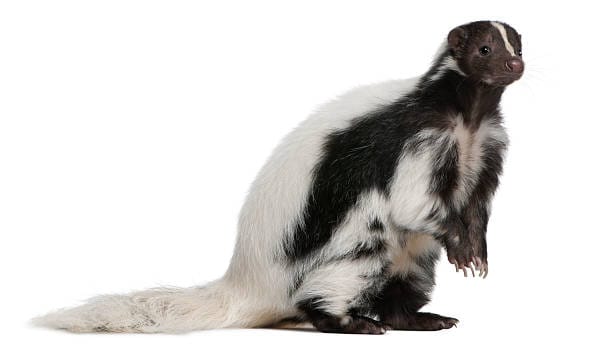
Physical Characteristics & Identification Tips
The Hooded Skunk is one of the most distinctive skunks in New Mexico due to its elongated body and hood-like white markings over the head and shoulders. Adults range from 24–34 inches long, including a tail that can account for nearly half their body length, and weigh between 3–7 pounds. The body is mostly black, but a prominent white stripe extends from the head to the shoulders, often resembling a draped hood, making it visually unique among regional skunks. Their long, thin build differentiates them from stockier Striped or Hog-nosed Skunks.
Behavior
Hooded Skunks are primarily nocturnal, using stealth and agility to forage. They are excellent diggers, often rooting in soft soil for insects, grubs, and small vertebrates. When threatened, they arch their back, raise their tail, and deliver an odoriferous spray if necessary. Compared to other species, they are more secretive and less likely to approach human habitation. Observers have noted their surprisingly quick reflexes and ability to escape predators using sudden bursts of speed and nimble maneuvers.
Habitat and Range
Hooded Skunks inhabit southern New Mexico, particularly desert and semi-arid grasslands, rocky hillsides, and scrublands. They favor areas with loose soil for burrowing and adequate cover for denning. These skunks often reuse burrows from other animals or natural crevices, moving between shelters seasonally. Their populations are patchy, reflecting habitat availability and human impact on semi-arid regions.
Diet
The diet is omnivorous, with a preference for insects, small mammals, reptiles, eggs, and occasionally plant matter such as berries. Their long snout and agile forepaws allow them to dig efficiently for subterranean insects or roots. Hooded Skunks also consume carrion when opportunities arise, contributing to ecosystem cleanliness. Their feeding behavior reduces pest insect populations, supporting both wild and agricultural ecosystems.
Reproduction and Life Cycle
Breeding takes place in late winter, with delayed implantation delaying embryonic development until conditions are favorable. Litters usually contain 3–6 kits, which are born blind and rely entirely on maternal care. Young are weaned after approximately eight weeks and begin dispersing by late summer. Hooded Skunks live around 5–6 years in the wild, facing threats from predators such as coyotes, bobcats, and large birds of prey.
Fun Facts / Unique Traits
Hooded Skunks can sometimes appear to “sway” their bodies when alarmed, a unique motion that enhances their warning display. The hood-like marking is thought to visually exaggerate their size, deterring predators before resorting to chemical defense. They are surprisingly agile climbers for their size and can scale low fences or rocks to access food or evade threats.
Human Interaction
While shy and reclusive, Hooded Skunks occasionally wander near rural residences. They rarely spray unless provoked, making conflicts uncommon. Observing them can be a delightful experience for wildlife enthusiasts, offering insight into New Mexico’s arid ecosystems and the specialized adaptations that allow these creatures to thrive in challenging habitats.
Frequently Asked Questions About Skunks in New Mexico
1. What are the most common types of skunks in New Mexico?
New Mexico hosts multiple skunk species including Striped Skunks, Spotted Skunks, Hog-nosed Skunks, Hooded Skunks, and Pygmy Skunks, each adapted to different habitats.
2. How many species of skunks live in New Mexico?
There are at least eight recognized species of skunks in New Mexico, ranging from small spotted skunks to larger striped and hog-nosed varieties.
3. Where can you find skunks in New Mexico?
Skunks in New Mexico inhabit deserts, grasslands, forests, agricultural fields, and even suburban areas with adequate cover and food sources.
4. Are there endangered skunks in New Mexico?
Currently, no skunk species in New Mexico are officially listed as endangered, though habitat loss can impact local populations.
5. What do skunks in New Mexico eat?
Skunks in New Mexico are omnivorous, feeding on insects, small mammals, eggs, fruits, berries, and occasionally carrion.
6. How can you identify skunks in New Mexico?
Identification relies on body size, fur color patterns, tail shape, and behavior. Striped skunks have bold central stripes, while spotted species display broken stripes or spots.
7. Do skunks in New Mexico spray often?
Skunks use their spray primarily as a last resort. Most skunks prefer warning displays or fleeing rather than deploying their potent scent.
8. What is the difference between skunk species in New Mexico?
Species vary in size, markings, tail shape, behavior, and habitat preference. For example, Spotted Skunks are smaller and more agile than Striped Skunks.
9. How big do skunks get in New Mexico?
Adult skunks range from 1.5 pounds in Pygmy Skunks to over 7 pounds in Hooded or Hog-nosed Skunks, with body lengths from 18 to 34 inches including the tail.
10. Are there spotted skunks in New Mexico?
Yes, several species of spotted skunks, including Western and Eastern Spotted Skunks, inhabit New Mexico’s diverse ecosystems.
11. Can skunks in New Mexico be kept as pets?
Keeping skunks as pets is generally discouraged and may be illegal. Native skunks are best observed in the wild for safety and conservation reasons.
12. What predators threaten skunks in New Mexico?
Common predators include coyotes, bobcats, foxes, large birds of prey, and domestic dogs. Their spray and warning behaviors are key defenses.
13. When do skunks in New Mexico breed?
Breeding typically occurs in late winter to early spring, with delayed implantation ensuring kits are born when food is abundant.
14. How long do skunks live in New Mexico?
Skunks usually live 3–7 years in the wild, with smaller species often having shorter lifespans due to predation.
15. Are skunks dangerous to humans in New Mexico?
Skunks are generally not aggressive but can spray when threatened. Rabies transmission is rare but possible, so caution is advised.
16. How do skunks in New Mexico survive the winter?
Many skunks hibernate or become less active during the cold months, seeking dens or burrows to conserve energy.
17. Do skunks in New Mexico live in urban areas?
Yes, some species adapt to suburban and rural areas where food sources like insects and rodents are plentiful.
18. How do skunks in New Mexico dig their burrows?
Skunks use strong forelimbs and claws to excavate dens in soil, under rocks, or in abandoned burrows of other animals.
19. What are fun facts about skunks in New Mexico?
Many skunks perform unique warning displays, such as handstand dances in spotted skunks, and are excellent nocturnal hunters.
20. How can farmers manage skunks in New Mexico?
Farmers can reduce skunk encounters by securing garbage, covering livestock feed, and installing fencing around poultry areas.
21. Are skunks in New Mexico active during the day or night?
Most skunks in New Mexico are nocturnal, foraging for food under cover of darkness.
22. What is the difference between striped and spotted skunks in New Mexico?
Striped skunks are larger with bold central stripes, while spotted skunks are smaller, more agile, and have broken stripes or spots.
23. How do skunks in New Mexico communicate with each other?
Skunks use scent marking, vocalizations, and body postures to communicate with mates and rivals.
24. Can skunks in New Mexico carry rabies?
Yes, although it is uncommon. Vaccination of pets and caution around wildlife reduces the risk of rabies transmission.
25. How can you safely observe skunks in New Mexico?
Observe from a distance at night using flashlights or motion-activated cameras. Avoid cornering or startling them to prevent spraying.
26. What role do skunks play in New Mexico’s ecosystem?
Skunks control insect and rodent populations, disperse seeds, and aerate soil, contributing to ecological balance.
27. Are there pygmy skunks in New Mexico?
Yes, Pygmy Skunks are small, secretive skunks found in select habitats across New Mexico.
28. How do Hooded Skunks survive in New Mexico’s deserts?
Hooded Skunks use burrows and crevices for shelter, forage nocturnally, and adapt to arid conditions by conserving water.
29. What types of habitats do skunks prefer in New Mexico?
Skunks favor grasslands, forests, shrublands, deserts, and areas with easy access to cover and food.
30. How do skunks in New Mexico impact gardens and crops?
Skunks eat insects and small rodents, benefiting crops, but may dig in gardens while foraging for grubs and worms.
31. Are skunks in New Mexico nocturnal or crepuscular?
Most skunks are nocturnal, though some may be active at dawn or dusk, especially during mating or food scarcity periods.
32. How can you distinguish a Hog-nosed Skunk in New Mexico from other skunks?
Hog-nosed Skunks have elongated snouts, large claws for digging, and a robust body, differentiating them from striped or spotted species.
33. What is the average weight of skunks in New Mexico?
Skunks range from about 1.5 pounds for Pygmy Skunks to over 7 pounds for Hooded or Hog-nosed Skunks.
34. Are there any unique behaviors of skunks in New Mexico?
Yes, behaviors include handstand warning displays, agile climbing, and nocturnal foraging strategies.
35. How do skunks in New Mexico defend themselves from predators?
Skunks primarily use their odor spray, warning displays, and nocturnal evasive tactics to protect themselves from predators.
Conclusion
New Mexico hosts a remarkable diversity of skunks, from the large Hog-nosed Skunk to the diminutive Pygmy Spotted Skunk, each adapted to thrive in specific habitats across the state. These Types of Skunks in New Mexico contribute significantly to ecosystem balance, acting as natural pest controllers, soil aerators, and indicators of environmental health. Their behaviors, from acrobatic handstands to clever burrowing, highlight the fascinating adaptations that allow skunks to survive and thrive. For wildlife enthusiasts, spotting these creatures is both a lesson in ecology and an invitation to appreciate the subtle intricacies of nocturnal life in New Mexico. Respecting their space while observing their fascinating behaviors ensures these skunks continue to flourish for generations to come.
Read more: 5 Types of Skunks in Iowa (Pictures And Identification)
